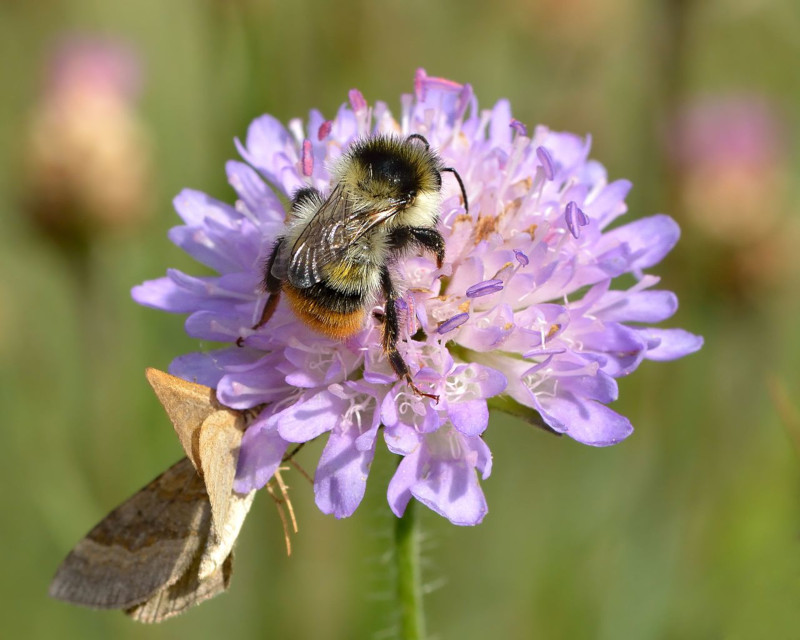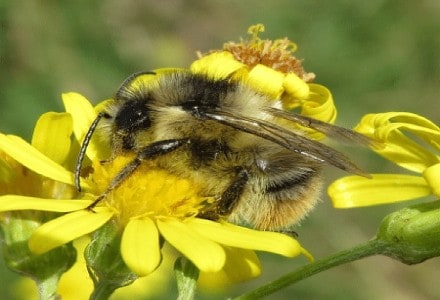
Shrill Carder Bee Facts
- Firstly, the term Shrill Carder Bee serves as the common name for the remarkable Bombus sylvarum. Secondly, it also goes by the alternate common name of the knapweed carder bee. But, by either term, the invertebrate stands out from related species for one very special reason. That’s the fact that this incredible insect ranks as one of the largest known forms of bumblebee.
- Lamentably, the animal appears to be experiencing a rapid decline in its numbers throughout the entirety of its range. Further, in some areas, this bee now appears only in isolated pockets of habitation. Consequently, in one country it inhabits it has now been declared an endangered species. Yet, like other bees, it nevertheless plays a vital role in our environment.
- Sadly, though, the Shrill Carder Bee faces many of the same threats to its existence as other insects. A few of these include the dangers of habitat loss and increased agricultural activity. Widespread use of commercial pesticides also poses a considerable threat to its existence. However, it also now faces the threat of climate change, much like many other species.
Related Articles
Ladybird Spider Tansy Beetle Hornet Robberfly
Shrill Carder Bee Physical Description
Perhaps the most distinctive fact about the fascinating insect known as the Shrill Carder Bee is its size. Like other bees, it also displays the trait of sexual dimorphism. In its case, though, the difference in size remains comparatively insignificant. Workers reach no more than 0.6 in (15 mm) in length, while queens only reach 0.7 in (18 mm).
In addition, its coloring presents as unique as well. While most bumblebees predominantly show yellow, this species displays a different pattern. It’s usually a grayish green. Further, a single black band appears across the thorax, and two across the abdomen. Still another unique pattern displays in the presence of an orange tip on the abdomen.
Though small, the Shrill Carder Bee evolved as an excellent flier. It’s also capable of moving rapidly. In addition, the wings of the queen actually generate an audible high-pitched buzzing sound in flight.While capable of stinging, it’s rarely aggressive unless threatened. Furthermore, the venom ranks as quite mild and is considered relatively harmless.
- Kingdom: Animalia
- Phylum: Arthropoda
- Class: Insecta
- Order: Hymenoptera
- Family: Apidae
- Genus: Mombus
- Species: B. sylvarum
Shrill Carder Bee Distribution, Habitat, and Ecology
While its numbers appear to be diminishing, in terms of area, the Shrill Carder Bee actually inhabits a comparatively large area. That holds true due to the fact that it lives across a wide swathe of the continent of Europe. Further, this broad range extends from the Ural Mountains to Great Britain, to Ireland, and even all the way to the southern portions of the country of Scandinavia.
However, the preferred habitat of the remarkable invertebrate accounts for its widely scattered concentrations. That’s because this small arthropod specifically prefers regions of herb-rich grasslands. Nests are typically constructed slightly beneath the surface and also amid relatively thick vegetation. Nevertheless, occasionally an abandoned vole or mouse nest will be utilized opportunistically.
Nests typically remain quite small, though. In point of fact, these rarely contain more than 100 workers, and a single queen. Understandably, the fascinating Shrill Carder Bee feeds on the nectar and pollen of numerous indigenous flowers. The bee has also been included in the United Kingdom Biodiversity Action Plan. This important inclusion justifiably occurs due to concerns over its dwindling numbers.
Species Sharing Its Range
Check out our other articles on 5 Incredible South American Islands, Puffin, La Brea Tar Pits, White Egret Orchid, Sarcastic Fringehead, Eastern Diamondback Rattlesnake, Wood Frog

